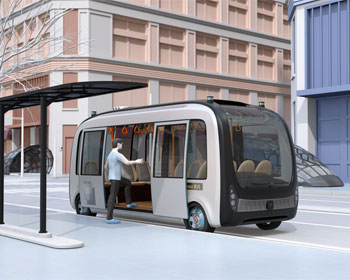Research Reports
Report Details
Abstract
 While the automobile industry is rapidly transitioning towards automation, the transit industry in the United States has recently begun investigating automation in transit operations. Multiple U.S. transit agencies have been experimenting with various automation technologies in transit vehicles. Examples of these technologies include lane-keep assist systems, collision avoidance systems, guidance systems for precise docking in Bus Rapid Transit, driverless shuttles (such as Navya, EasyMile, etc.,), etc. With various levels of transit automation technologies currently available and more advanced versions likely to be on the market soon, it is important to identify and understand transit automation technologies in the context of transit agencies' needs for implementing these technologies.
While the automobile industry is rapidly transitioning towards automation, the transit industry in the United States has recently begun investigating automation in transit operations. Multiple U.S. transit agencies have been experimenting with various automation technologies in transit vehicles. Examples of these technologies include lane-keep assist systems, collision avoidance systems, guidance systems for precise docking in Bus Rapid Transit, driverless shuttles (such as Navya, EasyMile, etc.,), etc. With various levels of transit automation technologies currently available and more advanced versions likely to be on the market soon, it is important to identify and understand transit automation technologies in the context of transit agencies' needs for implementing these technologies.
This study initially identified various U.S. transit industry uses of automation technologies and conducted a national survey of transit agencies in rural, small-urban, and urban areas to gather input about aspects of bus transit automated technologies and their implementation. A total of 258 responses were received from U.S. transit agencies; 157 responses from rural transit agencies, 67 from small-urban transit agencies, and 34 from urban transit agencies. Transit agencies believed transit vehicles with all Society of Automotive Engineers (SAE) levels (1 to 5) can promote safety. However, because safety of higher levels of automated transit vehicles (SAE levels 4 and 5) has not been extensively studied in all sizes of communities and types of environments, there were concerns and unanswered questions among some transit agency respondents about the technology's effectiveness, reliability, and performance. While levels 4 and 5 don't need to have a driver, transit agencies feel that the vehicles would still need an operator/agent to provide focused customer support and monitor the operating environment.



 While the automobile industry is rapidly transitioning towards automation, the transit industry in the United States has recently begun investigating automation in transit operations. Multiple U.S. transit agencies have been experimenting with various automation technologies in transit vehicles. Examples of these technologies include lane-keep assist systems, collision avoidance systems, guidance systems for precise docking in Bus Rapid Transit, driverless shuttles (such as Navya, EasyMile, etc.,), etc. With various levels of transit automation technologies currently available and more advanced versions likely to be on the market soon, it is important to identify and understand transit automation technologies in the context of transit agencies' needs for implementing these technologies.
While the automobile industry is rapidly transitioning towards automation, the transit industry in the United States has recently begun investigating automation in transit operations. Multiple U.S. transit agencies have been experimenting with various automation technologies in transit vehicles. Examples of these technologies include lane-keep assist systems, collision avoidance systems, guidance systems for precise docking in Bus Rapid Transit, driverless shuttles (such as Navya, EasyMile, etc.,), etc. With various levels of transit automation technologies currently available and more advanced versions likely to be on the market soon, it is important to identify and understand transit automation technologies in the context of transit agencies' needs for implementing these technologies.